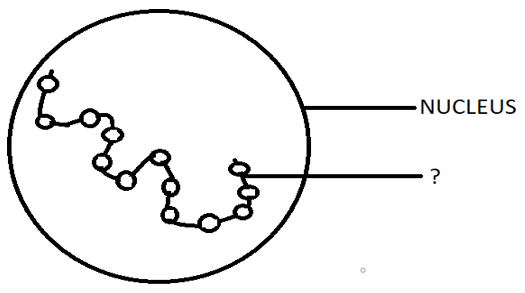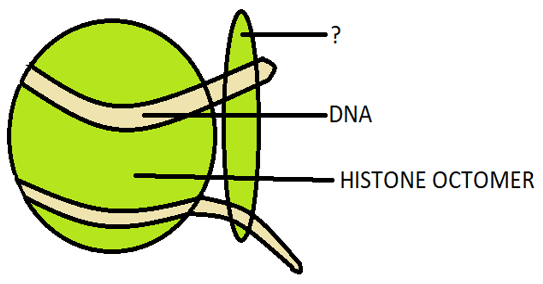This set of Class 12 Biology Chapter 6 Multiple Choice Questions & Answers (MCQs) focuses on “Packaging of DNA Helix”.
1. What is the length of the DNA double helix, if the total number of bp (base pair) is 6.6 x 109?
a) 2.2 m/bp
b) 2.5 m/bp
c) 2.2 m
d) 2.5 m
View Answer
Explanation: The distance between 2 consecutive bp is 0.34 nm. The formula to calculate the length of the DNA double helix:
The length of the DNA double helix = The total number of bp x distance between two consecutive bp.
As a result, we get 2.2 m as the length of the DNA double helix.
2. The DNA of the E. coli is scattered throughout the cell.
a) True
b) False
View Answer
Explanation: E. coli is a prokaryotic cell. Prokaryotic cells do not have a well-defined nucleus. In eukaryotes, the genetic material which is the DNA is present in the nucleus. Even though the prokaryotes lack a nuclear structure, their DNA is not scattered throughout the cell. The nuclear material in a prokaryote is called as a nucleoid. The nucleoid has the DNA inside of it. It will be circular in shape. And so, the DNA is not scattered throughout the cell.
3. What are the set of positively charged basic proteins called as?
a) Histidine
b) DNA
c) RNA
d) Histones
View Answer
Explanation: Histones are rich in basic amino acid (AA) residues such as lysine and arginine. These two amino acids carry a positive charge at their side chains. Due to this reason, histones are called as the set of positively charged basic proteins.
4. What are the thread-like stained structures present in the nucleus known as?
a) Chromosome
b) Chromatid
c) Chromatin
d) Chloroplast
View Answer
Explanation: A chromatin is a long thread-like structure which contains the nucleosome. Chromosome is a form which is achieved by the chromatin when it is undergoing cell division. In this form, both of the sister chromatids will be attached together at the centromere. Chromatids or sister chromatids are the thread like structures which are achieved when the chromosome is cut longitudinally during cell division. Chloroplast is a plastid that contains the green pigment chlorophyll.
5. How many bp are present in a typical nucleosome?
a) 200 bp
b) 100 bp
c) 300 bp
d) 90 bp
View Answer
Explanation: Nucleosomes are the bead-like structures which are present on a chromatin. These nucleosomes contain the DNA, which is the genetic material. Such a typical nucleosome contains nearly 200 bp.
6. When the negatively charged DNA combines with the positively charged histone octamer, which of the following is formed?
a) Nucleus
b) Nucleoid
c) Nucleosome
d) Nucleosome
View Answer
Explanation: Nucleosomes are the bead-like structures which are present on the strands of chromatin. These nucleosomes are formed when the DNA combines with the histone octamer. Less than 2 DNA turns can be seen which are wound around the octameric protein (Histones).
7. How many nucleosomes are present in a mammalian cell?
a) 20 million
b) 30 million
c) 40 million
d) 10 million
View Answer
Explanation: The diploid cell of a eukaryotic mammal contains 6.4 x 109 nucleotides. A single cell of such type will 30 million nucleosomes in it. Nucleosomes containing chromatin when viewed under an electron microscope appear to be like “Beads-on-string”.
8. Which of the following chromatins are said to be transcriptionally active and inactive respectively?
a) Euchromatin, Heterochromatin
b) Euchromatin, Prochromatin
c) Prochromatin, Euchromatin
d) Heterochromatin, Euchromatin
View Answer
Explanation: Inside the typical structure of a nucleus, the part of the chromatin which is considerably loose and stains light is said to be the Euchromatins. Likewise, the part of the chromatin which is considerably dense and stains dark is said to be the Heterochromatins. The part which is loose is said to be transcriptionally active, and the dense part is said to be transcriptionally inactive.
9. What are the additional set of proteins which are required for the packaging of chromatin at the higher levels known as?
a) Histone proteins
b) Non-Histone proteins
c) Histone chromosomal proteins
d) Non-Histone chromosomal proteins
View Answer
Explanation: NHC or Non-Histone Chromosomal proteins are the collection of proteins that act in a eukaryotic nucleus. They are responsible for the processes of DNA replication, RNA synthesis, RNA processes and also nuclear processes.
10. What is the typical distance between two base pairs in nm?
a) 0.34 nm
b) 0.32 nm
c) 0.33 nm
d) 0.35 nm
View Answer
Explanation: The double stranded helical structure of the DNA, takes a turn after every 10 base pairs which is noted to be as 3.4 nm. This is called as a pitch (distance). 0.34 nm is considered to be the distance between 2 base pairs.
11. What is the structure present inside the nucleus known as?

a) Chromosome
b) Chromatid
c) Ribosome
d) Lysosome
View Answer
Explanation: The structure present inside the nucleus is known as the chromatid. The small circular structures which are present on it are called as the nucleosomes. Chromosomes are the condensed form of the chromatids. Ribosome are the components which help in the synthesis of proteins. Lysosome are the cell components which are also known are the suicidal bags of the cells.
12. The DNA helical structure is linked to which type of histone protein in the following diagram?

a) H2A histones
b) H1 histones
c) H2B histones
d) H3 histones
View Answer
Explanation: H1 histones are commonly known as the linker histones. These histones can be located at the passage ways of the DNA, namely the entry and the exit sites. It is mostly found in protists and bacteria. It is also commonly known as nucleoproteins.
Sanfoundry Global Education & Learning Series – Biology – Class 12.
To practice all chapters and topics of class 12 Biology, here is complete set of 1000+ Multiple Choice Questions and Answers.
If you find a mistake in question / option / answer, kindly take a screenshot and email to [email protected]
- Practice Class 11 - Biology MCQs
- Practice Class 12 - Physics MCQs
- Check Class 12 - Biology Books
- Practice Class 12 - Chemistry MCQs
- Practice Class 12 - Mathematics MCQs
